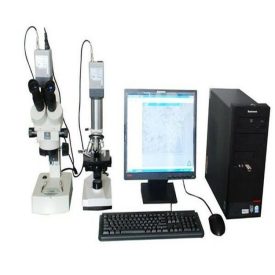
Fiber fineness analyzer
Applicable scope:
The fiber fineness analyzer is a new type of human-machine interactive fiber diameter measurement analyzer. This instrument connects an optical microscope to a computer through a high-resolution industrial camera, and relies on professional analysis software to complete fiber diameter and cross-sectional area testing. It can be used to measure the diameter of animal fibers such as wool and rabbit hair, as well as to determine the content of various natural and artificial mixed fibers. Measurement range: 2-200 ч m. Precision 0.1 ч M.
Compliant with standards:
GB/T 10685-2007 "Test method for diameter of wool fibers - Projection microscope method"
GB/T 13835.6-2009 "Test methods for rabbit hair fibers - Part 6: Diameter projection microscopy method"
GB/T 3364-2008 Test Method for Diameter and Number of Carbon Fibers
GB/T 16988 "Determination of content of special animal fibers and wool mixtures"
FZ/T30003 "Quantitative analysis method for cotton and linen blended products - Microscopic projection method"
SN/T0756 "Quantitative analysis method for imported and exported hemp/cotton blended products - Microscopic projection method"
Features:
1. The system adopts computer digital image processing technology and consists of a computer, a camera, a microscope, a printer, and detection software. Provide automatic fiber diameter measurement function and hotline assistance function.
2. Used to observe the cross-sectional morphology and measure the cross-sectional area of various animal fibers, chemical fibers, irregular fibers, and hollow fibers;
3. Test the degree of irregularity of shaped fibers;
4. By analyzing the cross-sectional shape and measuring the area of a single fiber in blended products, the fiber content of various blended products can be obtained;
5. Using professional analysis software, data and reports are output in EXCEL, and standard reports are provided.
Function Introduction:
1. Qualitative analysis of fibers:
FZ/T 01057.3 "Experimental Methods for Identification of Textile Fibers Part 3: Microscopic Method"
AATCC 20 Qualitative Analysis of Fibers
2. Fiber diameter experiment:
GB/T 10685 "Test method for diameter of wool fibers - Projection microscope method"
ISO 137 "Determination of wool fiber diameter - Projection microscopy method"
IWTO-8 "Method for determining the diameter distribution of wool fibers and the percentage of myelination of wool and other animal fibers using a microprojector"
GB/T 3364 "Test Method for Diameter and Equivalent Diameter of Carbon Fibers (Microscopic Method)"
3. Automatic diameter measurement:
GB/T 20732-2006 Fiber diameter optical analyzer
IWTO-47-00 "Optical fiber diameter analyzer - Method for determining the average diameter and distribution of wool fibers"
4. Fiber content experiment:
GB/T 16988 "Determination of content of special animal fibers and wool mixtures"
ISO 17751:2007 "Microscopic quantitative analysis of animal fibers - Cashmere, wool, other animal hairs and their mixtures"
FZ/T 30003-2009 "Quantitative Analysis Methods for Cotton and Hemp Blended Products - Microscopic Projection Method"
FZ/T 32004-2009 "Quantitative analysis methods for cotton and linen blended products - Microscopic projection method"
Technical parameters:
1. Working mode: manual measurement, automatic measurement, multi-point measurement; Automatic statistical analysis, report printing, photo printing
2. Instrument structure: computer, CCD camera, microscope, printer
3. Measurement range: 1-2000 um
4. Measurement accuracy: 0.01 um
5. Power supply: AC220V 50Hz 100W
6. External dimensions: 1200 x 500 x 600
7. Weight: 25kg
There are two functions for instrument diameter measurement to choose from:
1. Longitudinal diameter measurement method
For fiber samples with a circular cross-section, the fibers can be directly arranged and laid parallel on a glass slide. The diameter can be automatically measured by clicking on the fiber edge and capturing the image on the screen through a fiber mirror.
2. Cross-sectional area method
For fiber samples with non circular cross-sections, the fiber samples are first sliced using a Hasselblad slicer. The sliced fiber samples are placed on a stage, and the cross-sectional area of the fibers is measured on the screen using a fiber camera. Then, it is automatically converted to an equivalent diameter.
Advantages:
1. Operators may not work in the darkroom to reduce fatigue and have demonstrative capabilities.
2. Improve efficiency, significantly improving detection speed compared to traditional methods.
3. The detection records can be printed out, improving rigor, and images can be printed out for disputed samples for future reference;
4. The detection effect can be improved for dark fibers without stripping the color
5. There are also English software, cross-sectional software, and cotton and linen software available.
Prev: VeriVide CAC60 color matching light box
Next: Breathability tester